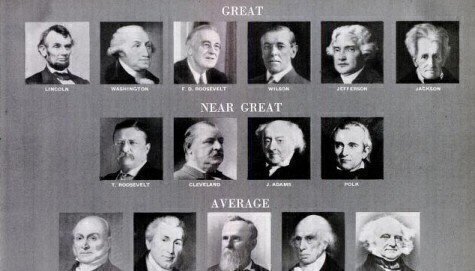In 2014, New York Times columnist Paul Krugman’s claims that Barack Obama should be considered one of the best recent presidents has generated a lot of debate. But how do historians and political scientists rank leaders over a long time span?

The jury is still out on President Obama, who has one year left in his second term. Krugman’s op-ed, which actually appeared in Rolling Stone magazine in 2014, argued that Obama should get credit for his action on health reform, financial reform, and environmental and social initiatives.
“Obama has emerged as one of the most consequential and, yes, successful presidents in American history,” Krugman said in a statement that many people have taken issue with since then.
Last February, a survey from the American Political Science Association had President Obama ranked in 18th place.
So how do historians come up with criteria to rank presidents? The concept goes back to 1948 and historian Arthur Schlesinger, who decided to poll other historians about the past performance of presidents.
Schlesinger polled 55 historians about five rating categories for an article in Life magazine. He noted that the hallmarks of what he considered “great presidents” were that they were strong “party men”; they weren't strong administrators; they had conflicts with the Supreme Court; and as strong leaders, they “arouse strong opposition.”
Schlesinger also said great presidents had to deal with a major turning point in history, and his list included George Washington, Abraham Lincoln, Franklin Roosevelt, Woodrow Wilson, Thomas Jefferson and Andrew Jackson.
Since his 1948 study, at least 16 other polls have attempted to get historians to rank presidents using broader sets of criteria. Siena College has conducted five of those surveys since 1982.
Siena uses 20 different criteria, with a possible high of 5 points for each category. The criteria include easily recognizable factors as foreign policy and communication ability, as well as more random factors such as luck and the opinions of other experts.
In the most-recent Siena poll in 2010, Obama was ranked 15th out of 42 presidents by a group of 200 scholars, despite only having held office for ability.
The folks at Siena also noted that over the years, historians do change their evaluations of presidents after several decades, pointing to the example of President Dwight D. Eisenhower.
In Schlesinger’s 1962 study, historians ranked Eisenhower as the 22nd best president, just two years after he left the White House. Twenty years later, Eisenhower had risen to number 11 in the Siena poll, and he is consistently between number 6 and number 10 in subsequent polls.
And then there is the case of Andrew Johnson, who was ranked 19th in the 1948 Schlesinger poll. As the Civil Rights movement unfolded, Johnson’s legacy received a great deal of historical revision, and he is now often considered as one of the three worst presidents in American history – at least by historians.
If popularity were an indicator of how well modern presidents (after Franklin Roosevelt) should be ranked, Ronald Reagan would top, or would be near the top, of any list.
A June 2014 Quinnipiac poll of about 1,400 registered voters had Reagan at the top, with 35 percent ranking him as the best president since World War II. Obama finished in fourth place among the best presidents, but he was also named the worst president by 33 percent of those polls, edging out his predecessor, George W. Bush.
John F. Kennedy and Reagan topped a similar Gallup poll in 2013 about the best post-World War II presidents.
For now, it may take several decades to get a clear sense of how historians will deal with Obama, Bush, Bill Clinton and George H.W. Bush.
Statistician Nate Silver calculated in 2013 that Obama could wind up ranked 17th when he leaves office, based on a statistical analysis of then-current presidential ranking polls.
“It is an extremely rough guide — especially for the presidents who are successful in winning a second term, and who have an opportunity to enhance or undermine their reputations. Voters may judge a president’s first term, but history will judge his second,” Silver said.







